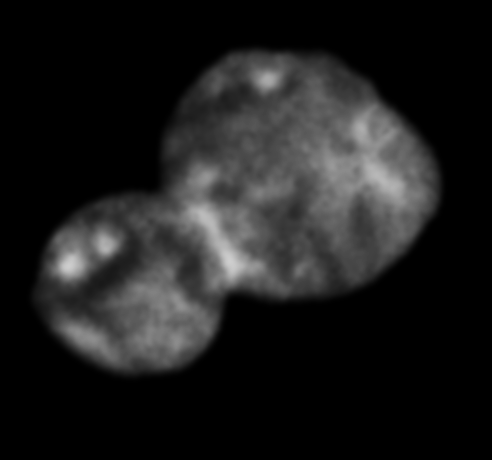
We now know what Ultima Thule looks like, and it’s not a bowling pin.
The first resolved photos of Ultima Thule have come in from NASA’s New Horizons spacecraft, which zoomed past the frigid faraway object just after midnight yesterday (Jan. 1). The historic imagery reveals that the 21-mile-long (33 kilometers) Ultima is a “contact binary” composed of two roughly spherical lobes.
Photos taken by New Horizons over the previous week or so had suggested that these two lobes are connected by a relatively narrow neck. But the new imagery shows they’re glommed tightly together, dashing earlier analogies. [New Horizons at Ultima Thule: Full Coverage]
“That bowling pin is gone,” New Horizons principal investigator Alan Stern, of the Southwest Research Institute (SwRI) in Boulder, Colorado, said during a news conference today (Jan. 2). “It’s a snowman, if it’s anything at all.”
Meet #UltimaThule! What you’re seeing is the 1st contact binary ever explored by a spacecraft. This object, which we can now see is a contact binary, used to be 2 separate objects that are now bound together. Watch for more @NASANewHorizons science results https://t.co/ZuxLDtzW9c pic.twitter.com/uF9VfgN4Fh
— NASA (@NASA) January 2, 2019

Ultima and Thule were once separate, free-flying objects; they coalesced long ago, just after the solar system’s birth, mission team members said. This union was not violent; the two bodies came together at about walking speed, in a meetup more akin to a spacecraft docking than to a collision, said Jeff Moore of NASA’s Ames Research Center, the leader of New Horizons’ geology and geophysics team.
Countless objects like Ultima Thule — which is officially known as 2014 MU69 — eventually built up our solar system’s planets. But that didn’t happen with Ultima Thule, which has remained pristine for eons in a cosmic deep-freeze, more than 4 billion miles (6.4 billion km) from the sun.












